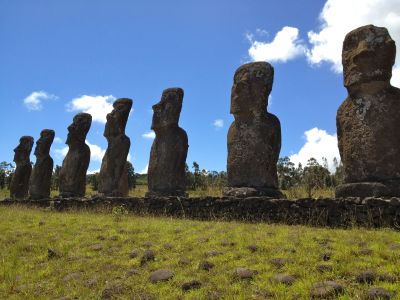Easter Island: A Lesson for Humanity
Share




Easter Island is a Polynesian island in the Southeast Pacific Ocean. It is one of the most remote inhabited places on Earth located about 3,600 kilometers away from South America. However, the isolated locale did not deter people from settling on the Island. What makes the Island famous worldwide are the head statues that adorn the Island. They are called Maoi and were created by the Rapa Nui people. Even though these big head statues are quite amazing, they were the reason of the decline of the Rapa Nui people. In 1995, UNESCO named Easter Island a World Heritage Site, with much of the Island protected within Rapa Nui National Park.
Polynesian people settled on Easter Island in the first millennium CE, and created a flourishing culture. The Rapa Nui civilization is one of the most famous ones known for bringing about its own demise. At its highest point the population is believed to have reached 20,000 people, but a century later, by the time of European arrival in 1722, the Island's population had dropped to around 3,000.
There are 877 stone statues of various sizes on Easter Island, that were probably built in a span of about 300 years between the twelfth and fifteenth centuries. The highest of them, called “Paro”, weighs over 80 tons. Many statues were never completed and are still attached to the stone quarry on the slopes of Rano-Raraku volcano, including one that measures about 21 meters and weighs about 270 tons.

The Easter Island society did not have to spend too much time on farming. This gave them plenty of free time in which they held many ceremonies. There were different clans on the Island, and each clan chief saw to the proceeding of elaborate rituals and monument construction. One of the monuments built were huge statues to represent the torso of a man. These statues took up immense amounts of peasant labor and was extremely time consuming. The statues were carved, using only obsidian stone tools. The most difficult issue faced by the islanders was the transportation of the statues in order to transfer them to the ceremonial platform. What solved the transportation problem caused the demise of these people.
Lacking any draught animals they had to rely on human power to drag the statues across the Island using tree trunks as rollers. As more and more chiefs vied to become more prestigious by erecting a bigger number of statues, the more trees were felled. That led to the deforestation of the whole Island and the collapse of the whole ecosystem. As the competition for resources increased, more and more people could not survive and the population dwindled away, as did the diverse and lush environment of the Island, leaving behind only a handful of descendents. In recent times, the Island has served as a warning of the cultural and environmental dangers of exploitation.